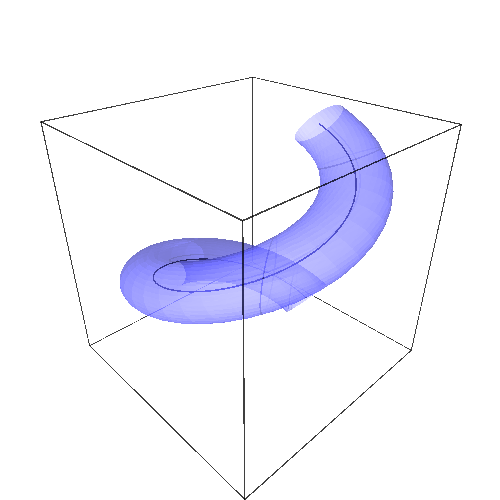Not (yet) a full answer (but see edit below if you are really stuck), but a (high-school level) hint, which, combined with FredericCs big fat one, should give you a solution :
Define the curve as a parametric callable symbolic expression :
t = SR.var("t")
C(t) = vector([cos(t), sin(t), t/2])
Tangeant :
T(t) = vector(map(lambda u:u.diff(t), C(t)))
# Its norm is time independant...
Tn = T(t).norm().simplify_full()
Normal (= acceleration)
N(t) = vector(map(lambda u:u.function(t).diff(t,2), C(t)))
# Again, time-independent norm :
Nn = N(t).norm().simplify_full()
Binormal :
B(t) = T(t).cross_product(N(t))
# Ditto...
Bn = B(t).norm().simplify_full()
A vector of points where we want to plot Frenet's trihedron
tPts = srange(-pi, 11*pi/10, pi/5)
3D plot of the curve itself :
P1 = parametric_plot3d(C, (-pi, pi), color="black")
Plot the (normed) tangeants :
P2 = sum(map(lambda u:line((C(u),C(u)+T(u)/Tn), color="blue", arrow_head=True),
tPts))
The normals :
P3 = sum(map(lambda u:line((C(u),C(u)+N(u)/Nn), color="red", arrow_head=True),
tPts))
The binormals :
P4 = sum(map(lambda u:line((C(u),C(u)+B(u)/Bn), color="green", arrow_head=True),
tPts))
Now, perusing parametric_plot3d? will show you that this function can plot surfaces having two parameters. This should be more than enough for your goal...
EDIT : Do not read this before doing an honest attempt at finding the solution yourself ; otherwise, you'd lose the benefit of the homework).
This result can be used to get the desired plot. Let's define a description of the normal section of the tube (here a circle of radius r) : the vector (N(t)/Nn, B(t)/Bn) is an orthonormal basis of the plane normal to C(t). Therefore, this description is :
# Radius of a circular-section tube
var("r")
# Parametric desription of the normal section of the tube
Ts(t,theta)=N(t)/Nn*r*cos(theta)+B(t)/Bn*r*sin(theta)
and the description of any point of the tube is :
# A point of the tube
Tu(t,theta)=C(t)+Ts(t, theta)
which can be plotted (along with its center curve) by :
P1 + parametric_plot3d(Tu.subs(r==1/3), (-pi, pi), (0, 2*pi), opacity=0.5)
which should give you something along the lines of :

Note that Sage's abilities in differential geometry may give you some radically different solutions. Left as an exercise for the (advanced) reader.
Bonus points : extrapolate to this... ;-)
HTH,


Homework ?
It is more like project because I get many points from this.
Okay. What do you call a "tubular surface around curve" ?
In plain English...
you should answer Emmanuel @Leon1403, because if it is just an appearance of a surface (a kind of plain tube surrounding the curve), it is easy , but on the other hand if it is a real surface, then me, personally I do not know how to do it !, but people on this site surely will know how to help you
Sorry, didn't see message sooner. English is not my native language but I will try to explain. This is how tube should look like. Curve should be inside of this tube. It is similar to charging cable. Plastic tube is surrounding wire.